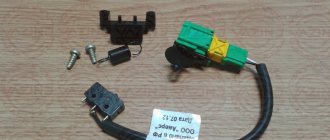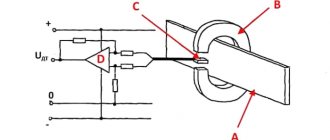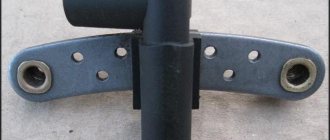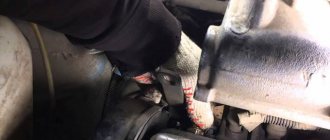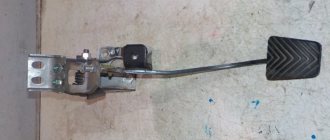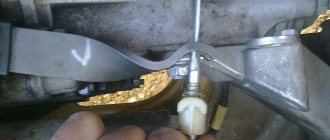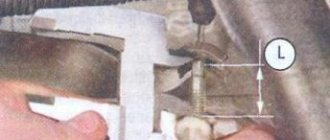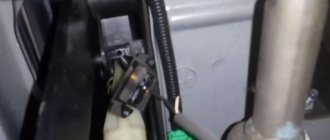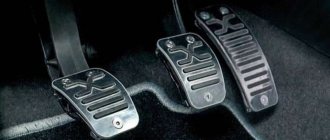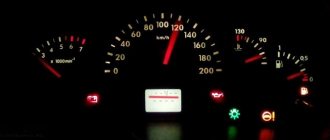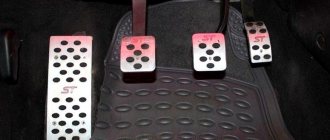10.03.2020
| (Votes: 1, Rating: 5) |
Issues discussed in the material:
- Meaning and design of the clutch
- What is a clutch pedal sensor used for?
- Clutch pedal sensor malfunctions
- How to repair and replace the clutch pedal sensor
The clutch pedal sensor is responsible for the smoothness of speed at idle and during shifts, and also affects the operation of cruise control. Malfunctions of this element will be noticeable immediately, and the driver’s task is to fix the problem in a short time.
There is nothing difficult in troubleshooting and replacing the pedal position sensor - even a novice motorist can remove and replace it by following the instructions given in the article. In addition, the number of necessary tools is small, and there is nothing specific among them. Also in the material we will tell you in more detail about the device and function of this sensor.
How does the electronic engine management system work?
The electronic engine control unit controls most of the vehicle's components, with the exception of the steering and suspension. ECU programs have presets (tables), on the basis of which optimal operating modes are calculated. Many sensors installed on a car read information about speed, movement, engine speed, mechanisms and drives. Based on the tables, the ECU changes the ignition mode, activates additional functions and regulates the composition and amount of the air-fuel mixture entering the cylinders.
Oil pressure sensor for Lada Granta
The oil pressure sensor should indicate the level of oil pressure in the engine. In the event of a drop in oil pressure, the sensor reports the incident to the BC, after which this data will be reflected on the BC or on the dashboard screen.
The principle of operation of this part is simple - the measuring membrane located inside it bends depending on the oil pressure, thereby closing or opening the contacts. A drop in the oil level in the engine causes the contacts to open, after which the warning lamp lights up.
The DDM includes three components: a housing, a measuring membrane and a transmitting element. The sensor is located behind the cylinder head, next to the timing belt guard.
If you suspect a malfunction of the oil pressure sensor on the Grant, you need to check the circuit going from it to the warning lamp. The test involves disconnecting the sensor terminal, which must then be placed against the engine. If everything is normal with the circuit, the lamp will stop lighting; if this does not happen, it means there has been a break or the circuit has been damaged.
Removal and installation
Replacing the brake pedal sensor on Kalina is done with an adjustable wrench set to “19”. The sensor itself is located above the brake pedal under the steering column. Conventionally, the withdrawal stages can be divided into 5 stages:
- Before starting work with an electrician, it is recommended to disconnect the negative wire (terminal) from the battery.
- Then you need to switch to the driver's side of the car. For ease of operation, it is recommended to move the driver's seat in the direction opposite to the dashboard.
- Find the location of the sensor. Find contact with wires. Press and hold the 2 plastic tabs located on either side of the chip. Pull the plug out of the sensor connector.
- Hold the wrench in your hands and loosen the lock nut. The sensor can then be unscrewed freely.
- The installation process is similar to the uninstallation procedure, except that you will need to make changes (adjustments), the process of which is described in detail in the previous section.
How to remove the comfort block to get to the clutch ends
Please tell me how to remove the comfort block (black flat box). When I disassembled the plastic and removed the dashboard itself, I took photos of it, but never took a photo. Right now the dashboard is installed, it’s cold outside, I’m scared about the plastic. I can't get to the clutch switches, this unit is in the way. Maybe someone remembers where to pull it. According to the available photos, it seems to be towards you (towards the interior) and down?
UPDATE 1
Thanks to everyone who responded. Got to the clutch end switches. To be honest, I still don’t understand how you can get to the top one (article 8200168239) without removing this comfort block, or without removing the dashboard. Maybe you can stick your hand through the wires and the base of the dashboard, but I don’t know how to carry out the manipulations... In principle, it’s normal to get to the bottom 8200168240 and manipulate it if you’re lying on your right shoulder blade with your head at the pedals.
1. remove the side plastic trim on the dashboard from the side of the door hinges (“triangle”); 2. remove the upper side trim going towards the threshold; 3. open the left cover of the bottom plastic panel, unscrew 3 screws, there is another 1 screw on the right side of the panel at the bottom. pull the latches out of the grooves. Also carefully remove the plastic block with the headlight and interior light adjustment buttons, disconnect the plug. Disconnect the plug from the fuse box.
4. Remove the block with relays and fuses from the holders on the left. Start from the top of the block - pry the top latch of the block itself and disengage it, push the bottom of the block towards the passenger compartment 5. remove the air duct under the steering wheel 6. “unlock” the position of the steering wheel - move the lever for adjusting the position of the steering column so that it does not interfere.
7. unscrew the screw in the center of the blackest box 8. remove the holders from the grooves (black circles with threads on the blackest box). I did it roughly, because the “pipe” prevents me from pressing and manipulating on the right 9. disconnect their plugs 5 All I had to do was disconnect the 4 2 lower ones - in the top center we feel for the plastic tab, press it towards the wires (towards the center of the chip) and pull the chip itself up ( perpendicular) 2 upper ones - we feel for the arc that snaps the plug, under it we feel for the “button” that blocks the self-transition of the arc from the vertical to the horizontal position. We press the button down and at the same time move the arc above the “button” away from the wires. 5th - I realized that it’s not easy there, there may not be enough nails, where to press, or even a screwdriver to press out some tab on this plug. I didn't take pictures. The black box has lowered, the “thick” braids of wires to this block no longer interfere. He reached everywhere and took everything off.
The limit switches themselves, as is known, are removed from their seats by turning 1/4 turn to the left (counterclockwise) and removed from the seat. On the plug, press the “tongues” in the center of the chip and pull it out of the end switch.
For the “top” (blue) art. 8200168239 I did not find a replacement article. Today, only analogues are available for sale (at a price).
But according to the lower art. 8200168240 there is an analogue of Renault art. 253250007R. Only it is positioned as a 3 Megane. I don’t know, maybe someone has already taken one of these?”
Source
Functions of the Priora clutch sensor
Data about the current operating mode of the clutch mechanism is important for engine control. If the clutch is disengaged, it is necessary to reduce the amount of fuel and reduce the engine speed. It is optimal to do this based on the current speed of the car, without idling. A driver, especially an inexperienced one, may make mistakes, which leads to increased load on the engine and clutch. The on-board computer, based on the readings of the clutch sensor, regulates the engine operating mode, setting the optimal speed. In addition, the clutch sensor on the Priora, in combination with the speed sensor, allows the computer to evaluate the performance of the unit and report problems.
Installation of a clutch sensor on a Priora is allowed:
- reduce fuel consumption;
- make driving easier and more fun;
- check the serviceability of the clutch;
- extend clutch life.
Therefore, the functionality of the sensor affects the service life of the units, fuel consumption and is extremely important for the proper functioning of the ECU.
Operating principle of the Priora clutch sensor
What is a Priora clutch sensor? The operating principle of the device is no different from a simple limit switch. When the pedal is not pressed and the clutch is engaged, the sensor contacts are open. When the transmission clutch is depressed, the limit switch closes, sending a signal to the computer to disengage the clutch disc and pressure plate.
The clutch sensor is installed on the pedal mount so that the toe of the pedal touches the limit switch.
The sensor design is simple and reliable, but this does not exclude the possibility of breakdowns and malfunctions in its operation.
Drive faults
Each type of drive has its own specific disadvantages. It is worth noting that many problems with clutch operation are related to the drive.
Cars often use a mechanical cable drive. The main malfunctions of a cable-driven clutch are as follows:
- violation of regulation;
- rope break;
- snacking.
The cable is adjusted using a nut, which allows you to change the length of the braid relative to the cable itself. If adjusted incorrectly, the cable becomes too tight or weakened, which leads to incorrect transmission of the driver's force to the mechanism.
Cable breakage is usually due to corrosion. With this malfunction of the clutch, its functioning completely stops.
Description of the clutch pedal sensor
What kind of device is this and how to replace it is below.
Purpose, location and operating principle
The clutch sensor is installed directly on the clutch pedal. It influences engine control via the electronic accelerator pedal and provides a convenient and flexible control scheme for machine operating modes. It itself is like a minor switch that has on and off modes.
Typical malfunctions and methods for their elimination
If the controller does not pick up signals from the clutch, there is a risk of error code 0830. This problem usually occurs due to a faulty clutch sensor or a short circuit or open circuit. To correct this state of affairs, it is necessary to identify the reasons. That is, inspect the contacts for cracks or corrosion.
Tool for replacing Lada Kalina
What is an electronic clutch?
Like any electronic system, the electronic clutch has its own control unit, which processes the received signals and transmits instructions for performing mechanical actions. In addition, this type of clutch combines various input and actuator devices.
Input devices include the clutch pedal unit and input sensors. The latter are the gas (accelerator) pedal location sensor and the gearbox lever location sensor. Although, according to car enthusiasts, there are many more of them, since the car moves without jerking, and the on-board computer tells you which gear is best to engage.
As for the electronic clutch system (not the pedal part), it has its own control unit. It receives and processes signals from input devices and transfers control to execution by the mechanical part. The unit interacts with the engine control system. This suggests that the car will have keyless entry or similar technology.
The executive part of the mechanisms is represented by an electrohydraulic drive (actuator), which stops the movement of the clutch fork based on a signal from the control unit.
How to understand when it's time to change the clutch
Mechanical clutch is a mechanism whose operating principle is based on the action of sliding friction. Often the term "clutch" is used to refer to one of the components of a vehicle's transmission that is used to connect the engine flywheel to the transmission. Depressing the clutch pedal temporarily disconnects power transmission from the engine.
The clutch mechanism is necessary so that you can move away smoothly without jerking. The speed of the car begins to increase only at a certain minimum number of engine revolutions. The clutch is also used when it is necessary to match the speed of the car and the number of revolutions of the crankshaft, that is, it ensures a smooth transfer of torque from the engine to the gearbox and, if necessary, completely disconnects the gears of a manual gearbox from the engine drive mechanism for a few moments.
There are several types of clutch. Often these are one, two or more friction discs pressed tightly against each other or against the flywheel using springs.
When the driver presses the pedal, the clutch discs are separated and an air gap appears between them, the clutch is disengaged at this time, and no torque is transferred from the engine to the gearbox. When the pedal is released, the pressure springs return the discs to their original position and again come into close contact; the torque of one of the driving discs is transmitted under the influence of friction to the driven disc.
The clutch is one of the most important parts of a car. Various types of these mechanisms are classified according to the control method, the type of friction operating in a given case (dry friction or wet friction), the number of disks, etc. As engine power increases, torque increases; accordingly, double-disc clutch units are used, which have a longer service life.
Sooner or later, clutch discs wear out and require replacement. A failed clutch can cause other parts of the vehicle to fail, such as the gears in the gearshift mechanism, or even prevent the vehicle from moving down the road.
How to understand when it's time to change the clutch
If you hear a loud noise from the release bearing when you release the clutch, it means it is worn out. Clutch wear results in higher and more expensive fuel consumption due to significant loss of engine power in this car group.
One of the clutch malfunctions is slipping of the discs when the pedal is released freely. When sliding relative to each other, the discs become very hot, which leads to rapid deformation or rupture of the discs. Friction linings burn, a specific smell is heard in the car interior.
How can you independently check faults in the clutch system without going to a gas station, as they say, in a popular way? The driver may notice disc slippage first in high gears. In this case, the engine speed increases, but the driving speed does not increase. Having noticed this state of affairs, it is necessary to take action as the process develops, intensifies and, ultimately, reaches a point where the car simply cannot move when engaging first gear.
How long does the clutch mechanism last? The answer to this question is ambiguous. After all, the durability of this mechanism depends not only on the quality of workmanship, but also on the experience and driving technique of the driver himself. According to the unspoken rule of motorists, discs are replaced after driving eighty to ninety thousand kilometers. But these indicators can deviate in any direction.
How else can you tell when it's time to replace the clutch?
The following “symptoms” can be listed:
· The clutch is engaged, i.e. the clutch is not completely disengaged. This can be seen by a loud squeaking noise when changing gears while the vehicle is stationary;
- · The car jerks even when the pedal is released fairly smoothly;
- · The clutch pedal is pressed all the way, but does not return to its original position;
- · When the clutch is engaged, strong vibration occurs.
It will be a shame to find yourself somewhere in the middle of the intended path, so do not put clutch replacement on the back burner.
If you have some experience, a special tool called a caliper will help you measure clutch wear. By following the instructions and having a lift, you can measure the thickness of the disk without disassembling it.
Replacing a clutch often requires removing the transmission. In general, it should be noted that replacing a clutch is a rather labor-intensive procedure, so if you don’t have the time, experience, great desire or anything else, then you need to go to a gas station. The procedure will not be cheap. But we do not recommend saving on this. It may be cheaper and better to replace the entire clutch (basket, discs, bearings) and lubricate the clutch release fork. Choose reliable manufacturers and reliable auto parts outlets.
How does the device work?
The operating principle of the clutch pusher detector is similar to that of conventional limit switches.
In this case, in a manual transmission the process will look like this:
- When you release the pedal while the mechanism is on, the sensor contacts are open.
- As soon as the driver presses the clutch drive, the limit switch will close.
- The sensor sends a notification to the ECU about the disconnection of the disk and the basket. Next, the control unit (electronics) properly regulates the operation of the mechanisms, based on the received message - changes the position of the clutch, selects the optimal gear.
In an automatic transmission, as we noted above, the device is called a selector sensor, the operating procedure is:
- The position of the selector lever changes.
- The sensor immediately informs the electronics of the machine about the position of the scenes.
- The program starts in the ECU (in the on-board computer).
- Upon notification, the hydraulic system begins to function. The necessary valves open and the required gear is engaged.
The clutch pedal position detector is actually a limit switch with a magnetic release and a Hall sensor that analyzes the position of the elements.
Possible breakdowns
Since the sensor is a kind of limit switch that works on/off, there are two options: pressing the pedal and releasing the pedal. Inside the sensor there is a special spring-loaded plastic, which can explode over time and therefore the return mechanism of the sensor will not work, which will lead to a constant closure of the contact and the ECU will receive a signal that the clutch pedal is in an inoperative state and is constantly pressed.
Also, the sensor control circuit is connected to it by soldering; most often, the wires are separated from each other by soldering, breaking the circuit. Upon inspection, it is quite easy to identify such a problem.
Where is the sensor located
The sensor is mounted directly on the clutch pedal bracket and is located in a hard-to-reach place behind the steering column. Although replacing it is very simple and boils down to disconnecting the wire block and unscrewing two fastening screws, getting to it from the interior is very difficult.
Some owners solve the problem of dismantling by taking advantage of the fact that in this place next to the vacuum brake booster under the hood there is a hatch closed with a lid. Removing it gives access to the pedal assembly.
To replace a part from the engine compartment, you will need the participation of an assistant, since you will have to simultaneously perform actions both in the engine compartment and in the cabin (by pressing the pedal).
Carrying out an inspection
To perform the procedure for checking the brake pedal sensor on a Grant, you will need to turn on the ignition, then press the brake pedal, paying attention to the brake lights - do they come on? The pedal should then be released, again focusing on the brake lights, which should now go out. If the brake lights do not light up, you should check the sensor itself, and also see if voltage is supplied from the battery to the wiring harness block.
During the test, circuit 1-4 must be closed and circuit 2-3 must be open. Then press the rod, usually chain 2-3 should close and chain 1-4 should open.
Similar sensors are installed on other VAZ models - Priora, Kalina and others, so the solution to the problem for these models will be exactly the same.
Absolute pressure and air temperature sensors for Lada Granta
These sensors are combined into one housing and installed on the receivers of the intake module; the most modern AvtoVAZ engines are equipped with them.
New Lada: Lada Granta automatic transmission repair in Tomsk. Affordable prices on PROFI.RU. Read reviews, choose according to specialist ratings
DBP on Grant differs in the output signal voltage within the range of 0.15..4.6 V, this voltage depends on the pressure level inside the intake pipe. The information it sends helps the ECU calculate the amount of air received by the intake pipe during one cycle.
A breakdown of the device circuit leads to an error code being entered into the system memory, and then the alarm turns on. After this, the control system calculates the air received based on the crankshaft speed, as well as based on the throttle valve opening angle.
The sensitive component of the DTV is the inlet pipe thermistor. The output signal voltage of the device connected to the computer will be approximately 0.3..4.9 V, it depends on the temperature of the air passing through the specified element. When a DTV failure is detected, the control system performs actions similar to its actions in the event of a DBP failure on a Lada Granta, replacing the readings of the described device with fixed temperature values.
Replacement instructions
The clutch transmits torque from the gearbox to the engine. The transmission is carried out thanks to the clutch cable, which connects the power unit to the gearbox and provides starting, gear shifting and braking. Thanks to the linkage mechanism, the car is set in motion.
Which clutch should you choose?
There are several types of clutch that differ:
- operating principle: electrical, mechanical and combined;
- working environment: air and oil bath;
- mechanism: groups of closed and alternately closed mechanisms;
- number of disks: single, double and multi-disk;
- number of springs: one or more;
- two streams.
The clutch is a complex mechanism, so before you replace it yourself with a Lada Kalina, you should carefully study the design and features of the mechanism.
VAZ 1117, 1118 and 1119 are equipped with 190 and 200 mm clutches. The diameter can be determined based on the number of starter mounting bolts. For 190 mm there are 3, and for 200 mm there are 2. Includes clutch disc, pressure plate and release bearing. The most famous brands: Valeo, Sachs, Luk, VIS, Kraft.
When using a unit of other models, you should pay attention to the flywheel, the type of which is determined by the number of starter pins. There are two of them in the Lada Kalina, and three in the VAZ 2108. The clutch life depends on the components and operating conditions. A high-quality unit can last for 100 thousand kilometers.
If you have problems with the clutch on the road, it is best to call a tow truck or tow the car with another vehicle, otherwise this may lead to transmission failure.
Tools
To replace the clutch, the car must be raised, since some of the work is performed from below. To do this, you can use an elevator, overpass or inspection pit. From the tools and materials for the DIY replacement procedure, you need to prepare:
When removing the transmission, the oil must be drained. If the work is done independently, then all the fat must be drained. If you have an assistant, you can drain some of the liquid from the threads so that the oil does not flow when they are disconnected.
Types of clutch on Kalina
, 1118 and 1119 two different types of clutch are installed at 190 and 220 millimeters. Determining the diameter is very simple, just pay attention to the number of starter mounting bolts. There are 3 of them by 190 mm and 2 by 200 mm. Regardless of the manufacturer, you will almost always find the clutch disc, pressure plate and release bearing assembly.
If you encounter problems with the clutch on the road, you need to have the car towed by a tow truck, as further movement may damage the transmission.
Preparatory work
It is no secret that work on replacing the clutch is carried out through disassembling the gearbox, so it is necessary to take care in advance of the presence of an inspection hole or overpass. We will also need the following tools and materials:
- New clutch kit.
- Set with tools.
- Hex key.
- Jack.
- Rags.
- Screwdriver.
- Container for draining oil.
- (if it is needed).
- Lamp for illuminating hard-to-reach places.
Step-by-step clutch replacement process
The first step in the work must be done under the hood of the car.
- Disconnect the power and negative cable from the battery, and then remove it.
- Then remove the air filter housing along with the corrugation.
- Remove all cables from the starter.
- We disassemble all the cables going to the gearbox and to the power supply.
Go to work under the car
We remove the gearbox and start working on the clutch.
If you are not confident in your abilities, you should not start this type of repair and you need to contact an auto repair shop for the most professional help.
Review of Manufacturer Prices
Technical parameters of the roller: 100 x 60 x 20 mm, weight 0.05 kg.
Related link:
How to remove moisture from Lada Granta headlights yourself
| Manufacturer | Price, rub.) | Resource (Thousand km) |
| VAZ 11180-1602266-00 cable lead | From 250 | 25 – 35 |
| 11180-1602210-00 cable assembly | From 300 | —/— |
| 21901-1602210-00 cable assembly | From 300 | —/— |
| 1118-3720015-00 DS | From 370 – 450 | —/— |
*prices are current as of October 26, 2018.
Equipment:
- Toad - switch 1118-3720015 – 1 piece;
- Housing 1118-3720024-10 – 1 piece;
- Screws 1-0076690-01 – 2 pcs;
- Spring 1118-1602179-00 – 1 pc.
Recommendations for selection and purchase
When purchasing spare parts, give preference to original products. Check the catalog numbers with the actual data specified in the instruction manual.
Buy consumables at official points of sale, dealership centers, and sales offices. Do not use the services of unverified suppliers who sell parts at an unusually low price. Cheapness is a sign of low quality and counterfeit.
Recently, it has become popular to order parts and then install them directly at the service station. In addition to professional installation, the customer receives a quality guarantee for the work performed, discounts, and bonus savings on the card.
Replacement algorithm
- It is necessary to remove the ripples from the air filter housing.
- Disconnect the terminals and other wires from the battery, remove the battery itself during repairs.
Exploded view of the engine compartment and battery.
- Unscrew the starter power supply wiring.
- From the control point it is necessary to remove the cable and wires, and also disassemble the motor protection.
Disconnect the gear shift lever.
- Clean the entire surface of the gearbox mounting to the engine and unscrew it.
We tie the box to the crossbar so that it does not fall.
- Remove the engine mount or lift it up.
- We unscrew the shafts from the gearbox using crabs.
We remove the wheel, lever and take out the transmission so that you can move the box without draining the oil.
- Move the transmission slightly away from the engine without removing the element, allowing you to begin replacing the clutch.
An engine mount is required because the mounting mounts have been removed and are shared between the engine and gearbox.
- Remove the bolts connecting the flywheel housing to the clutch disc. Press the flywheel itself with a screwdriver, while the bolts should gradually rotate in a circle.
After pulling out the box, a gap is formed that allows you to remove the clutch basket.
- Remove the disc and set it aside, even if it is in good condition. Inspect the flywheel for dents, scratches or other damage.
The clutch is old: the seals are finished and the disc is already worn with rivets.
- Install new parts or a new clutch part.
Before installing new parts, lubricate the clutch fork.
- When working with the basket, you need to “center” the disk inside. To do this, the driven element is inserted and then the pressure sheath. The spindle helps simplify the task, and when installing the elements, you need to fill the new basket, insert the centering piece into the disk and insert the flywheel.
A plastic bushing is used for alignment (some manufacturers include it in the clutch kit).
- Tighten the bolts evenly in a circle to secure the transmission to the engine.
- Connect the cable and wiring and make changes to make the entire system work properly.
Even when the first signs of a clutch malfunction appear, it is recommended to start purchasing spare parts and quickly prepare to replace the entire set.
Minor problems are always easier and cheaper to fix than major component repairs.
Symptoms of replacement
Mechanical damage can be seen only after removing the clutch from the car, but its wear can be understood by some changes that have appeared in the operation of the mechanism.
Complete replacement is recommended by the manufacturer for the following symptoms:
- Lead starts, in other words, engine power decreases.
- Slippage appears and engagement is incomplete.
- When changing gears, extraneous sounds, jolts or clicks appear.
- Sometimes the grip is lost.
- Vibrations occur when you press the clutch pedal.
When you press the clutch pedal, it falls through without effort, and with the engine running, it is impossible to engage the gear.
This is the most honest mistake. Occurs when the transmission clutch is damaged.
— the clutch cable is torn / the hydraulic drive is damaged (repaired by replacement and adjustment).
- the clutch fork was cleaned and put on the hinge (repaired by replacement or welding and adjustment).
The smell of burnt pads.
This is a very unpleasant and peculiar smell. This cannot be confused with anything.
This usually happens when starting from a stop, when trying to accelerate at high speed and when driving uphill. The reason lies in severe wear of the clutch disc. There is nothing left of its friction linings. It looks something like this:
If your car is very, very old or Chinese, the springs in the clutch basket may be worn out, but I have never seen this happen in practice.
You cannot drive for a long time with this malfunction, since slipping quickly wears out the basket and flywheel.
The only solution is to replace the clutch disc. In this case, it is advisable to replace the launch pad. Since they last about the same, they are inexpensive, and replacing them requires removing the transmission.
When driving in high gears, when you sharply press the gas pedal, the vehicle speed does not change, but the engine speed increases.
The reasons are exactly the same as in the previous case: wear of the friction linings of the driven disk.
It’s just that when driving at speed, the engine compartment and underbody are well ventilated and you can’t always smell it.
Sometimes the cause of such clutch failure is an oily clutch, but this is extremely rare.
When you press the clutch pedal, you hear a hum, noise, or grinding noise.
The reason, in most cases, lies in the wear of the thrust bearing. Depending on the design, it is modified or filled with lubricant (mainly on old machines).
You can drive for a long time with this malfunction; it is not very comfortable from an acoustics point of view. It is also important to understand that there is a possibility that the bearing will seize completely.
A guaranteed solution to the problem is to replace the thrust bearing.
A temporary solution to the problem, for example, when selling a car, is to weld the bearing in refractory grease.
It is important to understand that the work of removing and installing a gearbox is many times more expensive than replacing a release bearing.
If you hear an unpleasant “high” squeak when you press the clutch, the release bearing is completely jammed and needs to be replaced urgently; if this is not done, you will also replace the clutch basket.
If the squeaking and rattling noise is quiet, the bearing in the flywheel may have broken. But in my practice the problem arose only once. It is usually changed when the clutch basket is removed or during an engine overhaul. This is generally necessary to better preserve the gearbox input shaft bearings, its oil seal and increase the service life of the clutch disc.
Vibrations when starting off and/or when changing gears.
Vibration is usually caused by the clutch disc. Damper springs usually break or wear out:
Or the friction linings are partially destroyed:
It happens that the clutch basket itself breaks:
If your car is equipped with a dual mass flywheel, this could be a problem.
The most unlikely scenario is that the clutch release pads are installed incorrectly. The likelihood of this is extremely low, since clutch baskets with cams have not been installed on cars for 25-30 years (except UAZ).
Only removing the gearbox and disassembling the clutch will help localize the problem.
Gears are shifted with great effort, and a grinding noise is heard when shifting.
These symptoms indicate that the clutch is not disengaging completely. These clutch plates are not completely separated and the clutch plate continues to rotate.
This may be due to:
- air in the transmission hydraulic coupling (it is necessary to remove air from the system and eliminate the causes of air ingress).
- deformation or extreme wear of the clutch fork (can only be eliminated by replacement; it is useless to correct the fork).
- Incorrect clutch adjustment (adjust according to instructions).
- by melting the release pad from the plastic casing, this is especially the case for Chevrolet Niva owners. (The solution to the problem is to replace the thrust bearing).
Mechanism malfunctions
To understand what kind of clutch malfunctions there are on the mechanism side, you need to understand its design. The single-disk mechanism consists of a basket with a drive disk, which is rigidly mounted on the flywheel. The drive disk has the ability to move inside the basket, but it is pressed against the flywheel by a spring diaphragm or cam springs. Between them there is a driven disk with friction linings, which is connected via a spline connection to the gearbox drive shaft. There is also a release bearing, the task of which is to act on the spring of the drive disk due to the force obtained through the drive.
Clutch malfunctions are often associated with deformation or breakage of components. Common ones are:
- wear or destruction of the friction linings of the driven disk;
- breakage of the diaphragm spring petals;
- damage to the driven disk;
- deformation of the drive disk or flywheel working surface;
- release bearing wear.
Signs indicating the need to adjust the clutch on a Lada Kalina
Among the obvious symptoms, such as: problems with gear shifting, extraneous sounds when pressing the clutch pedal, poor clutch and not fully disengaged clutch, there are other signs that indicate the need to adjust the Lada Kalina clutch. To identify them, do a simple test.
- The engine must be completely turned off.
- Press the clutch pedal several times and listen for any abnormal sounds when pressed, such as rubbing, squeaking, clicking, etc.
- Pay attention to the presence of bindings when pedaling. If you can't feel it with your foot, try pressing the pedal with your hand and check the stroke.
- If the pedal jerks or sticks while driving, the clutch will most likely need adjustment.
Other signs of the need to adjust the clutch of your Lada Kalina:
- Take a ruler and check the distance from the floor of the car to the outside of the pedal.
- Press the pedal all the way down until it touches the floor.
- Release and check the distance again, if it exceeds 14.6 cm, the pedal stroke needs to be adjusted.
- If: the full pedal stroke is 14.6 cm, the bottom cable moves freely relative to the release fork lever by more than 2.7 cm, there is an eccentricity of the driven disc pads of more than 0.5 mm and the distance between the pads and rivets is less than 0.2 mm - The clutch needs to be adjusted or completely replaced.
How to properly adjust the clutch on a Lada Kalina with your own hands?
- Open the hood and remove the air filter.
- Locate the cable lug and pull on it to ensure maximum tension on the cable.
- Use a caliper to check the distance between the fork and the drive. If the distance is greater than 2.7cm, turn the screwdriver on the tip wire to adjust the size.
- While adjusting the distance, press the clutch several times and check the clearance again. If there is a shift, correct it again. You need to do this until you get the desired result.
If you still have not been able to adjust the clutch on Kalina, contact a specialist or make a complete replacement. Even if you were unable to adjust the clutch, you are unlikely to have to deal with replacement.
Purpose, types
The purpose of the clutch is to briefly disconnect the engine and gearbox so that the gear ratio in the box can be changed, as well as ensuring a smooth start to movement.
There are several types used on cars:
- frictional (also mechanical);
- hydraulic;
- electric.
The most widespread is the friction type. It is used together with mechanical and robotic ones. In automatic and CVT transmissions, the torque converter plays the role of clutch.
We will not touch on the clutch of automatic and CVT transmissions for now; we will focus on the friction clutch, since it is common in passenger vehicles.
Release bearing wear
Release bearing wear manifests itself as follows.
When you press the clutch pedal you hear a loud noise. The mechanism begins to work and applies a load to the deformed bearing, hence the sound.
In addition, another indicator is strange vibrations that occur when the car is moving. If necessary, the release switch is replaced. Hydraulically driven release bearings have many other problems. The clutch pedal becomes very soft and stops working, and the brake fluid leaks. And the clutch also stops working. A good clutch works like this: torque is transmitted very smoothly. The car handles smoothly on the road, without jolts or drifts. There are no unnecessary sounds when changing gears. The pedal is pressed easily, the machine does not make any extraneous sounds.
Meaning and design of the clutch
Without a clutch, the transmission will not work properly. It is located between the engine and the gearbox and provides stepwise gear shifting, controls torque, and also temporarily interrupts the connection between the flywheel and the transmission.
The clutch operates thanks to the force of friction (sliding) and includes the mechanism itself and the drive. When the driver needs to brake sharply, it allows the transmission to be preserved, eliminating overload.
If the car has a manual transmission, then the driver controls the clutch using the pedal. It allows you to connect and disconnect the motor and gearbox. The person behind the wheel releases the pedal, and it returns to its original position due to the spring.
If you drive a car with a manual transmission, keeping the pedal constantly depressed, the transmission will overheat and fail. Driving with slipping is only possible in exceptional situations in order to increase the speed.
There is no clutch in hydromechanical gearboxes, as well as in variators. However, hydromechanical type gearboxes have friction clutches that allow you to change gears smoothly. The classic assembly is found only in a robotic gearbox; in this case, gears are switched thanks to servos, which can be hydraulic or electronic.
Often, 2 clutches are used in a robotic gearbox to make shifting without delays and also to increase the efficiency of the transmission. How such a box functions: the first clutch works, while the second one is in a waiting state to change gear.
As mentioned earlier, this unit consists directly of the mechanism itself and the drive. The design includes:
- Pressure disk (or basket) . All other elements of the mechanism depend on this part. Contacts the release springs directed towards the center. The dimensions of the site are directly proportional to the two radii of the flywheel of the internal combustion engine. The main difference between the clamping section is that grinding is done only on one side. The disk is tightly connected to the flywheel of the internal combustion engine.
- The driven disk is located between the clamping section and the flywheel . It is in direct contact with the gearbox thanks to a splined coupling and friction linings. The coupling is framed by damper springs, which absorb all the vibration.
- Friction linings are located at the base ; they are usually made from various composite materials.
- Release bearing . Divided into two halves, the first has a round base to allow action on the basket springs. The bearing can be a pull-out or a pressure bearing and is located on the shaft casing. Pulling bearings are used in Peugeot cars. In some cases, a bearing may have multiple retaining springs.
- Drive and also pedal . If your car has an automatic transmission, then there is only a mechanism.
The principle of operation of the clutch is based on friction between the discs. The drive disk is an integral part of the motor, while the driven disk belongs to the gearbox. The person behind the wheel releases the pedal, at which point the springs compress the discs together. Thanks to the friction surfaces, the discs grind in and continue to rotate at the same angular speed. The force of the spring petals determines the abrasive value of the disc.
We recommend
When you press the pedal, the fork moves due to the drive base. The fork then acts on the bearing, moving it all the way. At the same time, the springs are ready to press the discs. This indicates that the connection between the gearbox and the engine flywheel has been broken by the fork. To absorb transmission shocks (when the pedal is suddenly released when the car starts moving), special springs are used.
The role of the clutch sensor
It would seem, but what does the clutch have to do with it? And here's what to do about it. When the clutch engages, it makes sense to slow down the engine. But not at the minimum, but in accordance with the speed of the car. This is not always available to a pilot, especially a novice. And here the computer will come to the rescue. In response to a signal from the clutch sensor, it can independently regulate the engine speed.
Important! In addition, in combination with the Priora speed sensor, the ECU can receive information about clutch maintenance.
Summarizing the above, we can say that the presence of a sensor on the clutch allows you to:
- save fuel;
- make driving easier;
- monitor the serviceability of the clutch;
- increase its duration.
Therefore, its functionality is an important factor in the Priora control system.”
Video “Eliminating squeaks”
You can learn how to solve one of the problems associated with the clutch in a car from the video from the author Konstantin Biyanov.
The widespread computerization of cars, adapting to consumer demand, non-stop pushes the best engineering minds to new discoveries. Every year, driving cars becomes more comfortable and safer - and all this thanks to all these innovations. Today we will talk about such an element as the clutch pedal sensor. There are two versions of the clutch sensor, which are not fundamentally different from each other - one is used in a robotic gearbox, the other in a manual one. What does the clutch sensor do? The answer is quite simple - the electronics send a signal to the control unit so that it, in turn, synchronizes the rotation of the engine crankshaft and the gearbox input shaft.
Clutch pedal position sensor VAZ
On the latest models of VAZ cars equipped with an electronic accelerator pedal, a clutch pedal position sensor is installed. Let's consider why it is needed, the principle of operation and possible malfunctions.
Where is the clutch sensor installed on VAZs?
The clutch pedal position sensor on VAZ cars is installed directly on the clutch pedal bracket; this can be seen by looking under the steering column.
What is a clutch sensor used for?
The clutch pedal position sensor is one of the elements of the engine management system with an electronic accelerator pedal. This sensor provides a more flexible control scheme for engine modes. It simplifies the process of starting movement, eliminates “dips” of turns and jerking of the car when changing gears in a manual transmission, and also allows you to reduce fuel consumption.
By providing the engine controller with information about when to engage and disengage the clutch, the clutch pedal position sensor allows you to reduce or increase engine speed at the right time, as well as adjust the ignition timing.
Working principle of the clutch sensor
The clutch pedal position sensor is a regular limit switch with two positions: “on” and “off”.
It is usually in the open position, which means it only engages when the clutch pedal is depressed.
Clutch position sensor malfunctions
The following symptoms may indicate a malfunction of the clutch pedal position sensor:
- "Pecking" of the car when changing gears
- a sharp increase or decrease in engine speed when the clutch is disengaged
In addition, if the clutch pedal position sensor is faulty, the engine controller corrects error 0830 “Clutch Pedal Sensor Error” and the “Check Engine” indicator lights up on the instrument panel.
Error 0830 is corrected if the motor controller does not receive a signal from the clutch sensor:
- within 2 seconds after changing gears while driving
- after four gear changes at speeds over 10 km/h and engine speed over 1000 rpm
The main reasons for error 0830:
- malfunction of the clutch sensor itself
- short circuit or break
- Incorrect clutch pedal height
Symptoms of this part being faulty
Since this element is connected to the ECU, it reacts to its failure first of all. That is, it gives peculiar signals that are reflected on the instrument panel and are noticeable in the behavior of the Priora when driving.
- turning on the “Check Anger” light;
- twitching when starting to move;
- a sharp drop or, conversely, an increase in speed when the clutch is engaged.
There can be three malfunctions in total: a breakdown of the sensor itself, a break or short circuit in its circuit, and incorrect adjustment of the position of the limit switch on the pedal.
Attention! Only Prioras, which have an electronic throttle, are equipped with such a device. Cars with a regular throttle cable do not have one.
It is also available for all-wheel drive VAZ. It must be remembered that these are two types of sensors, and they are not interchangeable!
In general, the “Check” warning lamp lights up in cases where the ECU has not received a signal within 2 seconds when starting from a stop or during four shifts on the move without a signal. Accordingly, the signs mentioned above appear.
Repair and service
On the latest models of VAZ cars equipped with an electronic accelerator pedal, a clutch pedal position sensor is installed. Let's consider why it is needed, the principle of operation and possible malfunctions.
Adjusting the brake pedal sensor Kalina
If the sensor is working properly and incorrect operation of the internal combustion engine continues to bother you, try adjusting the product yourself
Please pay attention to the following characteristics:
- The sensor must be twisted clockwise until the brake pedal begins to move down. After this, you will need to unscrew the product slightly and secure its position with a fastening nut.
- The result should be such that when there is no action on the pedal, the sensor rod is recessed into the body, and when the pedal is pressed, on the contrary, it is completely disengaged.
- As for the working gap, it is adjusted by two cubes (one at the top, the other at the bottom). The adjustment is carried out using the upper nut, which is tightened, and the lower nut, on the contrary, is unscrewed. The entire process is carried out until, when the brake pedal is pressed, the button is completely recessed into the body. However, you should not go overboard with the adjustment, in other words, you should leave a slight gap or lag in the path (about 2 to 5 millimeters).
Clutch sensor price
On many VAZ cars with an electronic accelerator pedal there is a connector for this sensor, but there is no sensor itself. It's unclear whether they forget to install it at the factory or remove it carelessly. The second option is also quite possible, since this sensor is still in great short supply. It costs an average of 350 rubles, but it is almost impossible to find it on the open market.
What to do?
Some clutch malfunctions can be eliminated even on the road, especially for problems with the drive (except electronic). It is also always possible to move even without a clutch. Almost all gearboxes are equipped with synchronizers that allow you to change gears while driving without a clutch (although this will not benefit the gearbox).
All that remains is to know how to start moving correctly. With a well-charged battery, the starter is able to start the engine in gear. That is, it is enough to engage first gear, and then use the starter to start the engine. In this case, the car will move jerkily until the engine starts. Further movement must be continued with the hazard lights on and at low speed. If the box is equipped with synchronizers, then shifting gears is allowed, as well as turning on “neutral”.
Diagnostic features
To diagnose the operation, you must first call the contacts individually, and then in pairs. If pins 2 and 3 are disconnected, this may indicate that they are faulty, especially since the other pins are making loud noises (video by Stas Garage).
To diagnose the work, you must first visually inspect it to see if there are any cracks or breaks. Then test the contacts to determine if there is a short circuit or break in the wire. In the event of a break, short circuit or corrosion of the wires, dismantle the part. How this simple manipulation is performed is below.
The most common causes of clutch system failure
The human factor can lead to premature failure of this unit. There are several factors that contribute to shortened clutch life:
- Aggressive driving style. Do not constantly press and release the clutch pedal - this will quickly cause the friction linings to fail.
- Driving with increased loads.
- Incorrect towing. Inexperienced car owners often keep the pedal halfway when towing. It is also not recommended to tow vehicles that are much heavier than your vehicle.
- Drive with the clutch pedal pressed to the floor.
- Sharp and too smooth start at high speeds.
- Many beginners often keep the clutch depressed during short stops (for example, at a traffic light). This should not be done, since in this position the release bearing is under constant load and this leads to its premature failure.
The clutch resource is quite long and ranges from 100 to 150 thousand km. When used correctly, the mechanism is quite reliable, and reaching the top bar is quite possible.
Sources
- https://auto-nota.ru/pro-motor/datchik-scepleniya-kalina.html
- https://avtoarsenal54.ru/ustrojstvo/datchik-stsepleniya-kalina-priznaki-neispravnosti.html
- https://vestaz.ru/boltaetsya-pedal-stsepleniya-na-kaline/
- https://LedStrong.ru/remont/datchik-scepleniya.html
- https://dmsht.ru/stseplenie-kalina-1-8kl-kakoe/
- https://korean-car.ru/menaem-sceplenie-na-lada-kalina-svoimi-rukami-ne-snimaa-korobki/
- https://autobryansk.info/priznaki-iznosa-sceplenija-kalina.html
- https://kekso.ru/avtovaz/priznaki-neispravnosti-sceplenija-lada-kalina/
- https://kalina-2.ru/otechestvennie-avto/kak-opredelit-chto-pora-menjat-sceplenie
- https://SpecTorg.su/dvigateli/datchik-pedali-scepleniya-kalina.html
- https://motorchina-online.ru/test-drajv/datchik-hoda-scepleniya.html
- https://artel55.ru/obzory-i-testy/zamena-datchika-scepleniya-granta.html
- https://LakkRoll.ru/regulirovka-kontsevika-pedali-tormoza-kalina/
- https://autogrm.ru/blog/kak-proverit-sceplenie.html
Symptoms of clutch malfunction
| List of faults | |
| The clutch "drives" | 1. The drive is out of adjustment or malfunctioning 2. Damage to the diaphragm spring 3. Damage to one of the disks or flywheel surface |
| Clutch slipping | 1. The drive is misaligned or malfunctioning 2. Wedging of the release bearing 3. Severe wear of the driven disk linings 4. Damage to the diaphragm spring |
| Increased noise | 1. Misadjustment of the drive or malfunction of its operation 2. Wear of the release bearing |
| Clutch won't disengage | 1. Damage to the cable (mechanical drive) 2. Depressurization of the system or air entering it (hydraulic drive) 3. Failure of sensors, control or actuator (electronic drive) |
| After pressing the clutch the pedal remains in the floor | 1. Jumping off of the return spring of the pedal 2. Jumping off of the return spring of the shift fork 3. Wedging of the release bearing |
| Jerks when moving | 1. Wear or damage to the driven disk linings 2. Deformation of the diaphragm spring 3. Wear of the damper springs 4. Damage to the drive disk |
Broken driven disc
